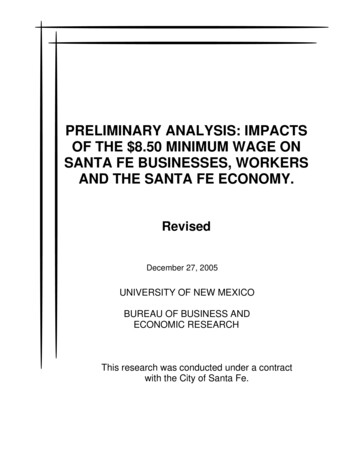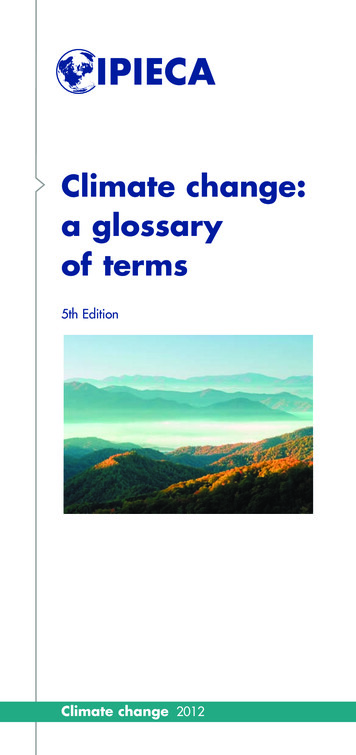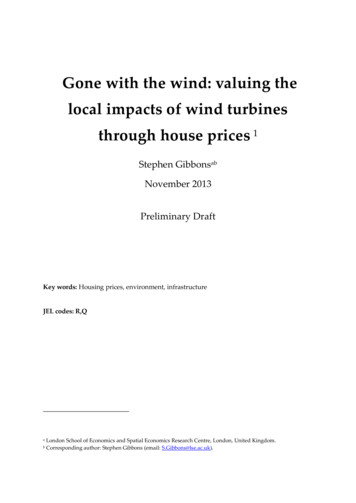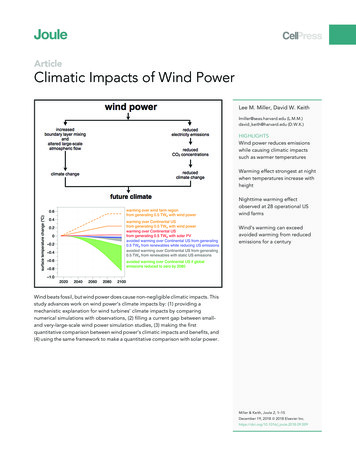
Transcription
PRELIMINARY ANALYSIS: IMPACTSOF THE 8.50 MINIMUM WAGE ONSANTA FE BUSINESSES, WORKERSAND THE SANTA FE ECONOMY.RevisedDecember 27, 2005UNIVERSITY OF NEW MEXICOBUREAU OF BUSINESS ANDECONOMIC RESEARCHThis research was conducted under a contractwith the City of Santa Fe.
ii
PRELIMINARY ANALYSIS OF THEIMPACTS OF THE 8.50 MINIMUM WAGEON SANTA FE BUSINESSES, WORKERSAND THE SANTA FE ECONOMYREVISEDDECEMBER 27, 2005Lee A. Reynis, PhDMyra Segal, MA, ConsultantMolly J. Bleecker, MAUNIVERSITY OF NEW MEXICOBUREAU OF BUSINESS ANDECONOMIC RESEARCHiii
iv
TABLE OF CONTENTSACKNOWLEDGEMENTSCHAPTER 1: INTRODUCTION .1CHAPTER 2: PRELIMINARY ANALYSIS OF DATA ON THE SANTA FEECONOMY .5Employment 5Unemployment and the Civilian Labor Force 9Earnings .10Reliance on Social Assistance Programs .14Gross Receipts Tax .17Construction Indicators .24Hospitality Industry Indicators .27Cost of Living 28CHAPTER 3: FINDINGS FROM BUSINESSES AND EMPLOYEE FOCUSGROUPS AND INTERVIEWS .31Summary of Focus Group and Interview Findings .31Methodology .33Findings from Employers .35Findings from the Employees .40CHAPTER 4; PRELIMINARY FINDINGS FROM THE BUSINESS SURVEY .49Methodology. .49Findings Regarding the Impacts of the 8.50 Minimum Wage 52Business Conditions and Challenges 55Hopes and Concerns Regarding the 9.50 Minimum Wage .56CHAPTER 5: POTENTIAL UNINTENDED CONSEQUENCES OF THE LIVINGWAGE .59Workers with Disabilities .59High School Students .60Health Insurance Benefits. .61Exemption of Businesses with under 25 Employees 62Other 63APPENDIX A: EMPLOYER FOCUS GROUP AND INTERVIEW QUESTIONS 67APPENDIX B: WORKER FOCUS GROUP AND INTERVIEW QUESTIONS 69APPENDIX C: QUESTIONNAIRE FOR WORKER FOCUS GROUPS 73APPENDIX D: SCREENING QUESTIONS TO ENSURE REPRESENTATIONMEETS OBJECTIVES . 77APPENDIX E: BUSINESS SURVEY 79v
vi
ACKNOWLEDGEMENTSThere are several people at the Bureau of Business and Economic Research whoprovided research assistance on this project and without whose help this phase ofthe project could never have been completed in time. Guy Dameron did an incrediblejob of managing the survey implementation, including compiling and cleaning themailing list, getting postcards and surveys ready to be mailed, and putting togetherteams of staff and students to stuff envelopes. Thanks to Betty Lujan, Betsy Eklundand Jack Baker of the staff for pitching in, along with students Colette Smith, LucindaSydow , Xiang Li and Austin Duus. One of our graduate students, Lucinda Sydowassisted Guy in assembling and checking the mailing list. She also designed and puttogether the database for analysis, taking responsibility for cleaning the data andcoding responses. Lucinda did the analysis using SPSS that resulted in the tables inChapter 4. Helping her in all these tasks was another graduate student, RishmaKhimji. In addition to her work on the survey, Rishma provided invaluable assistancein the focus groups. Rishma made many phone calls in an effort to contact potentialfocus group participants and she also assisted by taking notes during the sessions.Elvira Lopez translated the worker scripts into Spanish and conducted a focus groupwith workers in Spanish. She was assisted by BBER staffer Jack Baker, who madenumerous phone calls in Spanish to line up participants and then took notes duringElvira’s focus group. Jeff Mitchell of our staff organized the effort to collect andanalyze data for the Cost of Living Index, while Betsy Eklund, Colette Smith andLucinda Sydow collected price data on site in Santa Fe. Data Bank manager KevinKargacin and staff Larry Compton provided invaluable assistance at many points aswe attempted to put together data series for the analysis in Chapter 2. BobGrassberger provided numerous helpful comments on the initial drafts of chapters 2and 4. Michael Byrnes ably handled the administrative side of things to make surethe necessary documents were in place.We wish to thank Simon Brackley of the Santa Fe Chamber of Commerce, DavidKaseman from the Santa Fe Business Alliance and Carol Oppenheimer and MortySimon from the Santa Fe Living Wage Network for the assistance they provided atmany stages in our research. There are many others to thank – those who patientlyanswered our questions, who made available data, who allowed themselves to beinterviewed, who participated in our focus groups, and who responded to our survey.Finally, the authors wish to thank the City of Santa Fe for providing funding for thisstudy and the City of Santa Fe staff for handling all arrangements so that we could dothis work and report our findings to date.vii
viii
CHAPTER 1INTRODUCTIONThis is the preliminary analysis of data relating to the impacts of the 8.50 minimumwage mandated by the Living Wage Ordinance on Santa Fe workers, businesses andthe Santa Fe economy. The final report will include a more complete analysis of datacollected under this first phase of the research project and a statistical analysis ofmicrodata available after the beginning of 2006.The Living Wage Ordinance, which went into effect on June 24, 2004, mandates an 8.50 minimum wage for all private businesses operating within the City limits that have25 or more employees. The law applies to all employees – part-time and full-time – andto contract workers as well. 1 The wage is slated to increase to 9.50 on January 1,2006 and to 10.50 on January 1, 2008. The Living Wage Ordinance is a major policyinitiative.Investigating the economy of a City is not like conducting a controlled experiment in ascientific laboratory. Many factors are at play in a regional economy, making it difficult toquantify the effects of a particular policy change, in this case the 8.50 minimum wage,on businesses, employees and the economy as a whole. Therefore, it is important to setthe stage for the analysis of the impact of the 8.50 minimum wage on the economy ofSanta Fe by describing the national, state, and local economic realities that are alsoimpacting the Santa Fe economy.When the law went into effect, the Santa Fe economy was in the process of recoveringfrom a period of slower growth that dates back to the mid-to-late 1990’s. The economyhad weathered a national recession and the sharp reduction in business and leisuretravel that occurred after 9-11 and as a result of the general slowdown of the nationaleconomy. The City had just embarked on an ambitious effort to develop and implementan economic development strategy for the future. Since the law was passed there havebeen a number of developments nationally, internationally, and within New Mexico thathave, to varying degrees, had an effect on businesses operating in Santa Fe, on theirworkers, on Santa Fe households, and on the overall direction and health of the SantaFe economy. These developments provide part of the context in which local businesses,local residents, local workers and business and leisure travelers are making decisionsthat impact economic outcomes. The list of developments is long but the followingshould give a sense of some of the changes since the University of New Mexico Bureauof Business and Economic Research (BBER) first did the baseline study in 2003: Various developments have pushed energy prices well above where they have been forsome two decades: 25 dollar a barrel oil is now over 60 a barrel, and the consensusis that oil prices may never again fall below 40 per barrel. The Henry Hub cash market1With the exception of non-profit organizations that provide home health care services with Medicaidreimbursement.1
price for natural gas, which was under 3.00 per million btu in the late 1990’s is nowover 12.00. 2 The lowest mortgage rates in four decades have stimulated a housing boom and pushedup housing prices in one market after another. Mortgage rates are now finally headedup. There is growing evidence that the national housing boom is coming to an end. Consumer spending on services, including tourism, has picked up nationally. The USdollar has depreciated considerably on foreign exchange markets and this has made theUS a more attractive travel destination. Nationally, businesses have enjoyed high profits and many are flush with cash. Sincemid-2003, businesses have been expanding, hiring more people and investing – initiallyin equipment and software, but now increasingly in plant as well. The recovery of the global economy has seen a dramatic increase in the demand for keymaterials used in industry and in construction. Prices for materials like steel, plastics,wood products and cement have been spiking and there are many reports of difficulties inobtaining supplies. There were major changes to the federal tax code in 2001 and 2003. Under theRichardson administration, the State has made major changes to the income tax, with aphased reduction in marginal rates, and to the gross receipts tax. The elimination of thetax on food and certain medical services would have drastically reduced localgovernment revenues. To fund a distribution that would hold local governmentsharmless, the State eliminated the 0.5 cent municipal credit, thus immediately increasingthe tax within municipal boundaries by this amount. Federal efforts at deficit reduction have tended to focus on programs that provide publicassistance to low income people. Essentially, the safety net has been torn, with morecosts pushed on to the state and less assistance available or only available with stringsattached.The New Mexico economy has generally preformed well over the past couple yearswhen compared with the US and with other states. Job growth has been in theneighborhood of 2%, with population growth about 1.3%. Job growth has beenconcentrated in construction, in government, primarily tribal employment (casinos),public schools and higher education (stimulated by the lottery scholarship program), andin health care and social assistance. There are growing opportunities in a number ofindustries, with major investments and expansions by new and existing manufacturingfirms (e.g, Intel, Temper-Pedic, Eclipse Aviation, and Nova Bus in Roswell, now underMillenium). Information services, which includes telecommunications, is finally comingback to life. Tourist activity is up. There is strong growth in professional, scientific andtechnical services.2Henry Hub Cash Market price, as forecast by Global Insight in late December 2005 for the finalquarter of 2005 and the first quarter of 2006. New Mexico producers generally receive prices that arelower than this benchmark. The benchmark has been sensitive to recent developments along the GulfCoast.2
Amidst all these changes and cross-currents, the economy of Santa Fe is doing quitewell. Private sector job growth in the second quarter of 2005 hit 2.6% year-overyear. 3 Construction activity is down in the County, so the sector that has been amajor generator of jobs statewide is now not providing a boost in Santa Fe. There isno oil and gas industry in Santa Fe, so there has been no attendant boost from highenergy prices. (Indeed, high prices for gasoline and for heating only serve to reducethe discretionary income available to households, while higher costs for gasoline andother motor vehicle fuels raise transportation costs for would-be travelers.) Rather,Santa Fe’s growth is coming from accommodations and food services, frominformation services, and from professional and business services.This report explores, to the maximum extent possible given the time and the dataavailable, how the 8.50 minimum wage imposed under the Living Wage Ordinancehas affected businesses and workers and the overall trajectory of the Santa Feeconomy. The 8.50 minimum wage has posed challenges as well as offeringopportunities -- to local businesses, workers and residents of the City of Santa Fe.The results of our research so far provide a lesson in how individuals and individualbusinesses may respond differently to similar challenges. A number of businesseshave chosen to fight the mandated living wage – in the courts, by holding theiremployment under 25, perhaps by disinvesting. Others have accepted the law andsought ways to make it work for their business and their employees.Chapter 2 reviews the Santa Fe economy before and after the imposition of the livingwage. We will look at the accumulating quantitative evidence that bears onemployment, unemployment, earnings, the use of public assistance, gross receiptstax revenues, construction activity, tourism, and the cost of living.Chapter 3 presents the results of a series of focus groups and interviews that wereconducted with Santa Fe businesses and low-wage workers.Chapter 4 presents preliminary results from a survey that was conducted of Santa Febusinesses.Chapter 5 looks at some areas of special concern and discusses the evidenceregarding what might be called “unintended consequences” of the higher minimumwage.3This figure is based on the New Mexico Department of Labor’s Quarterly Census of Employmentand Earnings. The Quarterly Census is produced from records of actual employment as reported forworkers covered for unemployment insurance, now about 97% of all employees.3
4
CHAPTER 2PRELIMINARY ANALYSIS OF DATAON THE SANTA FE ECONOMYThis chapter reports the evidence from accumulating secondary data sources on theperformance of the Santa Fe economy before and after the implementation of theLiving Wage Ordinance on July 1, 2004. The final section of the chapter presentsBBER’s estimates of increases in the cost of living since the baseline study in 2003.EMPLOYMENTFor decades, the standard argument against the minimum wage has been that it willreduce employment. As was discussed in our baseline report, the empirical evidenceon employment impacts is mixed. Card and Kruger did not find reductions inemployment 4 ; in other studies, the employment impacts, while negative, have oftenbeen found to be relatively small.BBER was able to access data from the New Mexico Department of Labor’sQuarterly Census of Employment and Wages through the second quarter of 2005 forSanta Fe County. This series is based on employers quarterly reporting on workerscovered for unemployment insurance. Nationally the employees covered by thesereports account for some 98% of all wage and salary workers. This is the best dataon employment and wages that exists. While BBER will not have access to theindividual employer and employee records until 2006, we were able to put togetherthe series by industry for the four quarters after implementation of the living wage.The results on employment by 2-digit industry are presented in Table 2.1. The topportion of the table presents the numbers of average employment by quarterbeginning a year before implementation, the third quarter of 2003. The lower portionof the table presents the year-over-year growth for each quarter for each industrybeginning with the third quarter of 2003. Totals are presented for all private sectoremployment and all government employment as well as the grand total.Overall employment has increased year-over-year in each quarter sinceimplementation. Figure 2.1 shows the increases in private sector employment byquarter for the two years before implementation and for the four quarters since thelaw went into effect. Government employment has also increased every quarter,although the performance has been more erratic. In the second quarter of 2005there is a particularly large increase from a year earlier in local governmentemployment. The public schools apparently discovered that they had not beenreporting a whole group of employees and have modified their procedures to ensure4· See David Card and Alan B. Krueger. Myth and Measurement: The New Economics of theMinimum Wage, Princeton Univ Press, 1995.5
Table 2.1SANTA FE COUNTY EMPLOYMENT FROM THE QUARTERLY CENSUS OF 89,8446,2181,2139,7006,344Government17,300Grand 535455,56616271728122,88Natural Resource, Mining & ConstructionManufacturingWholesale tradeRetail tradeTransportation & warehousingInformationFinance & insuranceReal estate & rental & leasingProfessional & technical servicesManagement, administrative & wasteEducational servicesHealth care & social assistanceArts, entertainment & recreationAccommodation & food servicesOther services, except public adminUtilities and Non-classifiable89Total private 48,495152535455,56616271728122,88Natural resource, mining & constructionManufacturingWholesale tradeRetail tradeTransportation & warehousingInformationFinance & insuranceReal estate & rental & leasingProfessional & technical servicesManagement, administrative & wasteEducational servicesHealth care & social assistanceArts, entertainment & recreationAccommodation & food servicesOther servicesUtilities and 63,270PERCENTAGE CHANGE QUARTER OVER SAME QUARTER YEAR d total2.43.01.41.31.31.21.43.589Total private sector919293FederalStateLocal9095Columns may not add due to rounding.Source: New Mexico Department of Labor, Quarterly Census of Employment and Wagesthat these workers will all be reported in the future. Here we are most concerned withprivate sector employment.The figures reported in the table for different private sector industries reflect netchanges. In any quarter new businesses may open and existing businesses mayexpand, while some businesses may close or reduce their workforce through layoff orattrition. When a large business opens or an existing business implements asizeable expansion, it can impact the overall numbers for the industry. In such aninstance there may be elevated growth rates for 4 quarters until the expansionbecomes part of the base used in calculating current growth rates. The reverse can6
Figure 2.1SANTA FE COUNTY AVERAGE QUARTERLY EMPLOYMENTTOTAL PRIVATE 041,00040,00039,000Q3Q4Q1Q2Data: New Mexico Department of Labor, Quarterly Census of Employment and Wageshappen when a large business shuts its doors or has a major layoff. Thusmanufacturing picks up at the beginning of 2004 after major losses quarter afterquarter in 2003. In the case where businesses serve a primarily local market, growthafter a major new player (e.g., a big box retailer) enters the market may fall to zero oreven below as existing businesses adjust and as the new player is absorbed into themarket. The aggregate numbers have less erratic movements but they are clearlyaffected by the different currents in different industries.Figure 2.2 and 2.3 examine the recent employment history for sectors that historicallyhave had a large proportion of low wage workers. Figure 2.2 presents the quarterlyyear over year growth rates for retail, accommodations and food services, and otherservices. Note that employment in the retail trade sector saw growth in the 1 to 2%range in the four quarters preceeding implementation. Employment has beenbasically flat (-1 to 1) since July 1, 2004. Other services had three quarters ofgrowth in the neighborhood of 4%. Growth decelerated in the fourth quarter of 2004to 2.0% and the sector has had year-over-year declines thus far in 2005. On theother hand, accommodations and food services has had relatively strong growthsince the second quarter of 2004.7
Figure 2.2SANTA FE COUNTY EMPLOYMENT GROWTHSELECTED INDUSTRIESQUARTERLY PERCENT INCREASE OVER YEAR AGO6.04.02.00.0-2.0Retail trade-4.0Accommodation & food servicesOther services-6.003Q304Q105Q1Figure 2.3 provides the same kind of analysis for administrative and waste services,arts, entertainment and recreation and natural resources and mining. Theadministrative and waste services sector includes employment in back office jobs andcall centers, payroll services and also temporary services. Note that employment inthese jobs has been growing at double-digit rates since implementation. The naturalresources and mining sector is tiny. There is some evidence of improvingemployment opportunities over the past few quarters. The arts, entertainment andrecreation sector (no government jobs) has about 1,000 employees today.Employment in this sector was down from 2003 in every quarter of 2004 but 2005has seen improvement.Figure 2.3SANTA FE COUNTY EMPLOYMENT GROWTHSELECTED INDUSTRIES 2QUARTERLY PERCENT INCREASE OVER YEAR AGO40.030.020.010.00.0-10.0Administrative & wasteservicesArts, entertainment &recreationNatural resources andmining-20.0-30.0-40.003Q304Q105Q18
One sector that employs low wage workers and that is very important to the overallSanta Fe County economy and local government revenues is construction.Figure 2.4 presents the data on construction employment as reported for constructionprojects within the County. Note that construction employment has been down inevery quarter since the third quarter of 2004. This is an interesting result and will bediscussed in a subsequent section dealing with construction indicators.Figure 2.4SANTA FE COUNTY AVERAGE QUARTERLY -054,4004,2004,0003,8003,6003,400Q3Q4Q1Q2Data: New Mexico Department of Labor, Quarterly Census of Employment and WagesOverall, the implementation of the living wage does not appear to have resulted inemployment declines. As the figures in Table 2.1 indicate, many sectors of the SantaFe economy have experienced strong growth since the minimum wage provisionswent into effect in July 2004, and a number of sectors with a significant number oflow wage workers have expanded. Construction has been booming in New Mexico,with the construction sector a major source of job gains. With high energy and othercommodity prices, mining and extractive industries have had major job gains. Takeaway this growth related to construction and oil and gas, and the private sectoremployment gains in Santa Fe County economy compare very favorably with thosefor New Mexico as a whole.UNEMPLOYMENT AND THE CIVILIAN LABOR FORCETrends in unemployment have been cited in an effort to show that the mandatedminimum wage has had an adverse affect on employment and on working people.The following chart based on the latest data available from the New MexicoDepartment of Labor shows that the Santa Fe MSA unemployment rate is todayhigher than it was a couple years ago, indeed well before the living wage came intoeffect. Figure 2.5 shows the monthly unemployment rates for Santa Fe sinceJanuary 2002 and offers a comparison with Albuquerque and Las Cruces and with9
Figure 2.5MONTHLY UNEMPLOYMENT RATESSANTA FE, ALBUQUERQUE & LAS CRUCES, STATE OF NEW MEXICO8.00%7.00%6.00%5.00%4.00%3.00%Santa Fe MSAAlbuquerque MSALas Cruces MSANEW MEXICO2.00%1.00%0.00%02030405Data: New Mexico Department of LaborNew Mexico as a whole. As the chart indicates, the unemployment rate in Santa Fecontinues to be well below than of the other two MSA’s and also the state as a whole.Unemployment is certainly higher in Santa Fe today than it was back in 2002, whenSanta Fe unemployment averaged 3.8%. Santa Fe unemployment averaged 4.3% in2003 and 2004. Without seasonal adjustment, Santa Fe unemployment hasaveraged 4.5% so far this year, but as the graph indicates, the last months of theyear typically see lower unemployment rates. So there is no clear evidence that therate has increased since July 2004. And a higher unemployment rate would notnecessarily mean reduced employment opportunities. Unemployment rates oftenrise during good times as people not in the labor force see improved jobopportunities. That this has happened in Santa Fe is indicated in the year-over-yeargrowth of the civilian labor force – over 3% in every month since February 2005. Thisrate is well above the growth seen throughout 2004 and also the historical trend forSanta Fe.EARNINGSThe best available data on wages for Santa Fe County is that collected by the NewMexico Department of Labor for employees covered by unemployment insurance.The same source that provided the information on employment also reportsinformation on average weekly earnings. Table 2.2 reports the average weeklywages by 2-digit NAICS sector.10
Table 2.2SANTA FE COUNTY AVERAGE WEEKLY WAGES BY 05Q1Q2Agriculture, forestry, fishing & lesale tradeRetail tradeTransportation & warehousingInformationFinance & insuranceReal estate & rental & leasingProfessional & technical servicesManagement of companies & enterprisesAdministrative & waste servicesEducational servicesHealth care & social assistanceArts, entertainment & recreationAccommodation & food servicesOther services, except public 397344683335161,080Total private 706351,0376835691,014776624Total d total561601571593572597594609603626594626* Totals suppressed to avoid disclosure.Source: New Mexico Department of Labor, Quarterly Census of Employment and WagesFigure 2.6 presents the data on total private sector average quarterly wages. Notethat average wages showed considerable improvement in the first half year followingFigure 2.6AVERAGE QUARTERLY PRIVATE SECTOR WAGESSANTA FE COUNTY 8002002-03 7002003-04 6002004-05 500 400 300 200 100 Q3Q4Q1Q2Data: New Mexico Department of Labor, Quarterly Census of Employment and Wages11
the implementation of living wage ordinance. Performance since then has been lessimpressive. There are, of course, many developments that can affect average wagesin a particular industry. Below in figures 2.7 through 2.10, we provide similar graphsfor a number of industries that employ a large number of lower wage workers:Figure 2.7SANTA FE COUNTY AVERAGE QUARTERLY WAGESRETAIL TRADENAICS 453 is 5,000,000 above 04-05 5602002-03 5402003-042004-05 520 500 480 460 440 420 400Q3Q4Q1Q2Data: New Mexico Department of Labor, Quarterly Census of Employment and WagesFigure 2.8SANTA FE COUNTY AVERAGE QUARTERLY WAGESACCOMMODATION AND FOOD SERVICES 3602002-03 3502003-04 3402004-05 330 320 310 300 290 280 270Q3Q4Q1Q2Data: New Mexico Department of Labor, Quarterly Census of Employment and WagesFigure 2.9SANTA FE COUNTY AVERAGE QUARTERLY WAGESARTS, ENTERTAINMENT AND RECREATION 8002002-03 7002003-04 6002004-05NAICS 711 employmentdoubles (perf arts) 500 400 300 200 100 Q3Q4Q1Q2Data: New Mexico Department of Labor, Quarterly Census of Employment and Wages12
Figure 2.10SANTA FE COUNTY AVERAGE QUARTERLY WAGESOTHER SERVICES 5402002-032003-04 5202004-05 500 480 460 440 420Q3Q4Q1Q2Data: New Mexico Department of Labor, Quarterly Census of Employment and WagesParticular circumstances help to explain developments over the past couple quarters.For example, quarterly wages in miscellaneous store retailers, the classification thatincludes art galleries, were exceptionally high in the first quarter of 2004 --about 5million higher than total reported earnings in the first quarter of 2005. On the otherhand, the drop off in average weekly wages in the arts, entertainment and recreationindustry in the second quarter of 2005
AND THE SANTA FE ECONOMY. Revised December 27, 2005 UNIVERSITY OF NEW MEXICO BUREAU OF BUSINESS AND ECONOMIC RESEARCH This research was conducted under a contract with the City of Santa Fe. ii. PRELIMINARY ANALYSIS OF THE IMPACTS OF THE 8.50 MINIMUM WAGE ON SANTA FE BUSINESSES, WORKERS










